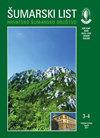利用GIS技术对森林采伐中电锯产生的人为噪声传播进行建模
IF 0.4
4区 农林科学
Q4 FORESTRY
引用次数: 1
摘要
噪音是一种环境污染,对人类健康产生负面影响,降低员工的工作效率。森林采伐活动是噪声影响较大的工作环境之一。在森林作业中最常用的设备是电锯,电锯的噪音不仅影响操作人员,也影响该地区的野生动物。显示噪声传播的噪声图可以有效地用于评价和控制噪声的影响。在这项研究中,它的目的是测量在树木砍伐中使用的电锯产生的人为噪声水平,并利用基于GIS(地理信息系统)的噪声预测软件SPreAD-GIS (System for Prediction of Acoustic Detectability)绘制其噪声传播图。这项研究是在土耳其布尔萨市的卡拉卡贝洪水泛滥的森林进行的。结果表明,电锯的平均噪音水平超过了危险限值(90 dBA),导致工人的生理反应增加和头痛。噪声传播图显示,采收过程中员工的噪声暴露量超过预警限值(85 dBA),最大噪声水平为95.96 dBA。在部分研究区域,噪音水平达到45 dBA或以上,对鸟类造成负面影响。结果表明,噪声图可以有效地用于确定电锯产生的噪声传播,并评估噪声对操作者和周围鸟类的影响。本文章由计算机程序翻译,如有差异,请以英文原文为准。
Using GIS techniques for modeling of anthropogenic noise propagation generated by a chainsaw in forest harvesting
Noise is an environmental pollution that negatively affects human health and reduces the performance of employees. Forest harvesting activities are one of the working environments where noise effect is intense. The most common equipment used in forest operations is chainsaw whose noise affects not only the operator but also the wildlife in the territory. The noise maps showing noise propagation can be effectively used in evaluating and controlling the noise effects. In this study, it was aimed to measure the anthropogenic noise levels resulting from the chainsaw used in tree felling and to map its noise propagation with SPreAD-GIS (System for Prediction of Acoustic Detectability) which is a GIS (Geographical Information Systems) based noise prediction software. The study was conducted in Karacabey Flooded Forest within the city of Bursa in Türkiye. The results indicated that the average noise level from the chainsaw was above the danger limit (90 dBA) that causes increased physiological reactions and headache on the workers. According to the noise propagation map, the noise exposure of the employees exceeded the warning limit (85 dBA) and the maximum noise level was 95.96 dBA during the harvesting activity. In some parts of the study area, the noise level was 45 dBA or above, causing negative effects on bird species. It can be concluded that the noise maps can be effectively used to determine noise propagation generated by a chainsaw and evaluate the noise effects on the operators and as well as on the bird species in the perimeter.
求助全文
通过发布文献求助,成功后即可免费获取论文全文。
去求助
来源期刊

Sumarski List
FORESTRY-
CiteScore
0.90
自引率
20.00%
发文量
32
审稿时长
>12 weeks
期刊介绍:
Forestry Journal publishes scientific and specialist articles from the fields of forestry, forestry-related scientific branches, nature protection and wildlife management.
 求助内容:
求助内容: 应助结果提醒方式:
应助结果提醒方式:


